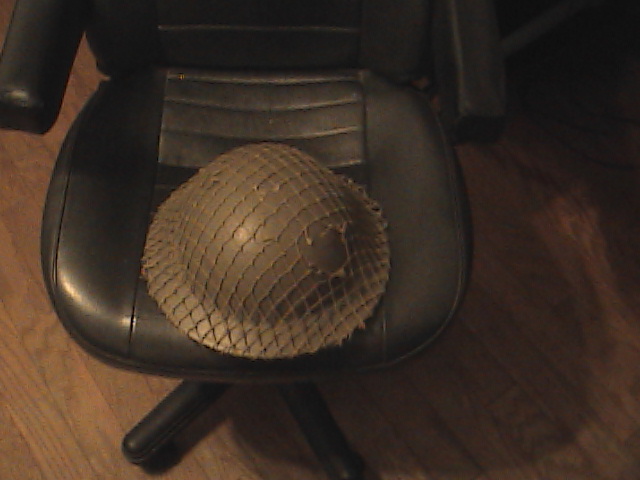"Berets in combat "only when the Sgt Major is not around, cause he would have a few “words” with the offender to dress regs…:)Followed with some extra work and drill …
Hi Guy’s
Nice pictures but there is a wrong caption the picture is not of a Royal Winnipeg Rifles soldier and the Div Patch is French Gray 3rd Cdn Div not blue 2nd Div is Dark Blue.
The Bren Gun eject out the bottom. from what I have read the 3rd British and 3rd Canadian were the only Div to use the Mk3 helmets on D DAY.
Cheers
http://www.ww2incolor.com/forum/showpost.php?p=82003&postcount=1

MKIII-H1C
Mk III “Turtle” Helmet
From “The Armed Forces of World War II”, by Andrew Mollo, Crown Publishers Inc., 1981 (p 230)
Thanks for the correction Gerry 
I vaguely recall reading something about the helmet being designed to defend primarily against air-burst shrapnel after the experiences of Tommies in the early days of WW1. I don’t recall exactly where I read that, so it might be complete bollocks, but it sounded likely to me.
just to say those para pics look really good, it still looks wierd to me in colour
a good site to use is www.army-surplus.org.uk for gear or www.forcesreunited.org.uk to get intouch with pals you had in the army!
As a Jock, I must point out that one should never refer to a member of the King’s Own Scottish Borderers (KOSB) as a ‘Kosbie’ as they discovered while serving in India that it is a swear word in one of the native tongues of that country.
Hi,
i have question about british pouches. I know, there was 2 types, one closed by snaps, and second closed by belts. I dont know how it’s called… You can see them on the picture below. And now, which was earlier type? I heard two different opinions. One told that earlier was that on snaps and second was inversely. And - what is the best i think - both people stand still, and they are ready to fight to prove their rights… In internet it’s the same thing.
i like the american helmet better but the british used the smae helmet in ww1 and ww2 and they used the same rifle the lee enfield .303
Cezar
Considering the tab-slide method was used on all British webbing from the ‘44’ pattern to to-days Personal Load Carrying Equipment (PLCE) so would say ‘for ammo pouches’ this is the best system. I found that press-studs on my kit could easily get damaged. they are used to secure the utility & water bottle pouches to the webb-belt.(PLCE)
Paul
Hi Cezar, the pouches you have there are typical post-war manufacture. There are still lots of WWII era-snap closure pouches available on the internet. Very nice group of items you have there.
iam new and seeing how i know nothing on helmets something ive had laying around for a couple years i had it looked at guy said it was a mark 2 tommy helmet for british troops in ww2 and would like some info on it

The Americans also used the British style helmet for a spell in the first stages of their involvement in WW 2.
Dura-Glit. Brasso was too messy. What a nostalgic thread this one is … all the heady fragances of my early recruit days came flooding back at once.
Cheers,
Cliff
Thanks 
But i have stamps inside each pouch. On one: MKIII - unreadable (MEC?) 1941 and arrow up, and on the oter everything is unreadable.
And other question, what about gas masks? I’ve found that type:

but what i heard, that type was issued in airborne units. And what about infantry? They were using MARK VII bags to the end of war?
Cesar
the respirator & pouch that you have is the 1943 Light Pattern Anti-Gas Respirator and Haversack. Though it is known as the Airborne type, it was issued to both infantry and supporting units.
Paul
Thanks! I want to be sure, because i have an opportunity to buy one in good price. 
Cezar
If you are going to buy them, then I suggest you look for the date of when they were produced. 'The earlier they are, the more rarer & thus expensive they will be. There are a lot of postwar ones about which are dirt cheap. But if I were you, I would get a WW-2 1943-44 type especially if you looking for authenticy.
Paul
It has stamps from 1944 
If you think you are getting the respirator & pouch for a good price, buy them, as you may not get a second chance.
Paul
the tab-and-loop style closure first appears on 1944 manufactured pouches … but you never see people using them during the war.
Blacked-painted steel fittings are another feature of postwar webbing … although virtually any piece of wartime stuff can be found with at least some (maybe just one) phosphated steel fittings randomly included.
The bayonet frog shown here appears to be a one-piece-loop No.6 postwar pattern.


